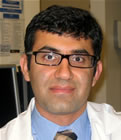
|
November 20, 2008 -- Phoenix, Arizona -- Several recent international studies have shown that catheterizations, angioplasty and stent placement, when performed from the wrist, result in lower bleeding complications, and are associated with a significant reduction in mortality. Even so, the wrist approach, also called transradial access, is performed in less than 4 out of 100 patients in the United States, although in Canada, Europe and Asia, use of the technique is far more common. One reason, says Dr. Mehrdad Saririan of Maricopa Medical Center in Phoenix, is that "there are a lot of myths surrounding radial procedures." Dr. Saririan hopes to dispel these myths, and train more cardiologists in this technique at his upcoming course on December 5, 2008, the first for Maricopa -- in fact Dr. Saririan and his colleague, Dr. Jay Kaufman, are the only physicians in the Phoenix area who routinely perform transradial coronary angiography and PCI. Like Dr. Saririan, most practitioners of this technique agree that one of the biggest roadblocks to wider practice of the transradial approach in the U.S. has been training -- few interventional fellowship programs offer this technique, so most cardiologists wishing to acquire the necessary skills must learn the procedure once they are in practice. Several centers in the U.S. where radial angioplasty is utilized have been offering courses for cardiologists -- and Maricopa Medical Center in Phoenix is the latest addition.
Although obvious advantages to the wrist technique are better outcomes, less complications and increased patient comfort (patients can walk almost immediately after a procedure, as opposed to laying flat for hours when the angioplasty is done from the femoral/leg approach) another advantage is lower cost. Dr. Saririan explains:
The course is being held on Friday, December 5, 2008, from 7:00am to 4:00pm at:
More information on registration can be found in this online brochure. The course receives support from Terumo Interventional Systems. About the Radial Access Center on Angioplasty.Org For patients there is also a "Hospital Locator" that lists U.S. centers practicing radial angiography.
Reported by Burt Cohen, November 20, 2008 |
